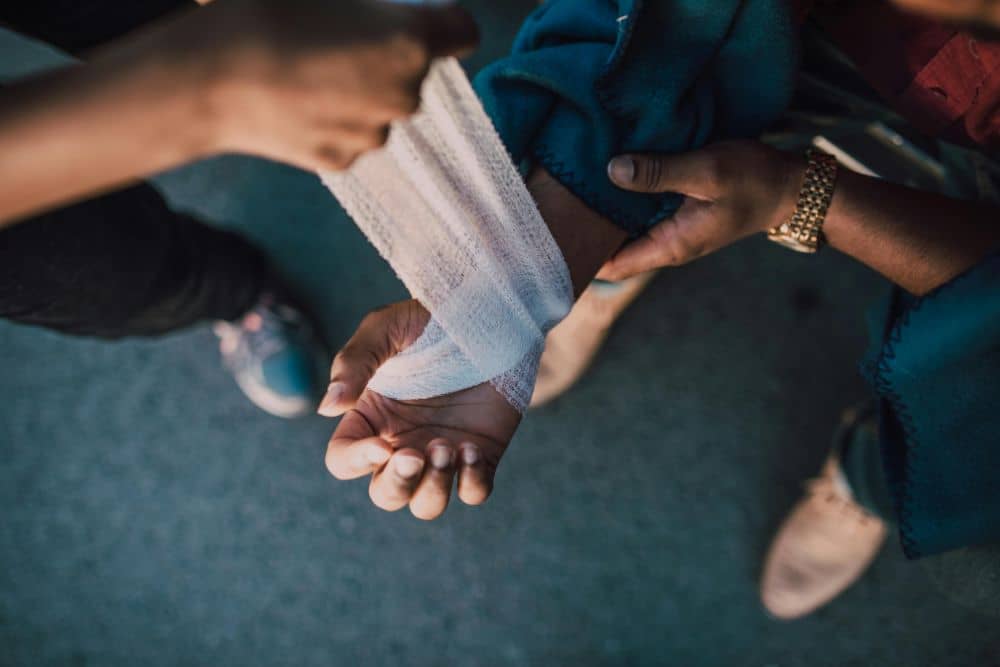What Constitutes Negligence in a Personal Injury Case?

Whether you were T-boned at an intersection by a distracted driver or took a nasty spill on a slippery grocery store floor, injuries caused by someone else’s carelessness are never pleasant experiences. When accidents like these happen, the key legal concept that determines if you’re entitled to compensation is negligence.
As personal injury attorneys, we’ve seen negligence play the central role in countless cases. At its core, it’s about one party failing to exercise the proper level of care, resulting in foreseeable harm to another.
To hold someone financially accountable and recover damages in Ohio, you’ll need to prove their actions (or inactions) meet all the legal criteria for negligence. It’s a critical hurdle, but one that our team has successfully cleared for clients time and again.
What is Negligence?
In basic terms, negligence occurs when a person or entity’s unreasonably careless behavior violates a duty of care owed to someone else, directly causing quantifiable injuries or losses. That’s the high-level definition, but bringing a valid negligence claim requires establishing some very specific legal elements.
Common examples of potential negligence include:
- A distracted driver running a red light and causing a collision
- A property owner failing to maintain their property in a safe condition leading to a slip and fall injury
- A doctor committing surgical errors due to fatigue or incompetence
- A company continuing unsafe workplace practices despite safety violations
Essentially, any situation where one party puts another at an unreasonable risk of harm through their careless conduct can open the door to negligence allegations.
The Four Elements of Negligence
To prove negligence and recover damages, Ohio courts require plaintiffs to establish evidence of four distinct elements. Think of it like a legal four-part test – you must convince the judge or jury of each component: duty of care, breach of duty, causation, and damages.
Element 1 – Duty of Care
The duty of care refers to a person or entity’s legal obligation to exercise reasonable care and prudence to avoid exposing others to foreseeable risks of harm. Common examples where a duty exists under Ohio law include:
- Motorists have a duty to obey traffic laws and drive attentively
- Doctors/medical providers have a duty to treat patients competently
- Property owners have a duty to maintain safe premises for guests
- Employers have a duty to provide workers with hazard-free environments
In some cases, state statutes and regulations help define the appropriate duty. In others, juries must decide if a duty existed based on the circumstances – essentially asking whether a “reasonable person” would have foreseen the potential danger and acted differently.
Element 2 – Breach of Duty
Once a duty is established, the next question is whether the defendant breached or violated that duty through specific actions or failures to act responsibly.
Examples of breached duties include:
- A distracted driver texting behind the wheel
- A doctor misreading test results or botching a routine procedure
- A store owner not cleaning up a slippery drink spill in a timely manner
- A company forcing employees to use faulty or unguarded machinery
Under the “negligence per se” doctrine, Ohio courts may even presume breach if the defendant violated relevant safety laws or regulations meant to prevent the type of harm caused.
Evidence is critical for proving a breach, whether eyewitness testimony, expert analysis, photo/video documentation, or records of prior safety complaints and violations.
Element 3 – Causation
To establish causation, you must demonstrate two components:
- The defendant’s breach of duty was the actual cause of your injuries – i.e., you wouldn’t have been harmed “but for” their negligent conduct.
- Your injuries were also a reasonably foreseeable consequence of the breach – known as “proximate cause.”
For example, if a speeding driver ran a red light and t-boned your vehicle, their breach of traffic safety laws directly caused your collision injuries. And a reasonable person could foresee colliding with cross-traffic as a likely outcome of reckless speeding and disregarding traffic signals.
Element 4 – Damages
The final element is proving you suffered actual, quantifiable damages in the form of bodily injuries, economic losses, emotional distress, or other recognized harms under Ohio personal injury law.
Common compensable damages include:
- Medical expenses (current and future costs)
- Lost income/wages
- Pain and suffering
- Permanent disability or disfigurement
- Loss of life’s enjoyment
Overall, you’ll need proof of real, measurable losses caused by the defendant’s negligence to recover damages. Photos, medical records, vocational experts, and other documentation become vital evidence.
Contributory vs Comparative Negligence in Ohio
Unlike some states with contributory negligence laws that completely bar recovery if a plaintiff shares any degree of fault, Ohio takes a more balanced approach. If you are not more than 50% at fault you can still recover damages from other liable parties in an incident – but your total award gets reduced by whatever percentage of negligence you’re assigned.
For example: If a jury finds you were 20% negligent for a car accident and assigns you $100,000 in damages against the defendant, your recovery would be reduced to $80,000 after your 20% contributory fault is calculated. This helps assign accountability more proportionately among all parties who may have contributed to negligent behavior rather than an all-or-nothing outcome.
Burden of Proof for Negligence Claims
To win a negligence claim in Ohio, the burden rests on the plaintiff to prove each of those four key elements by a “preponderance of the evidence.” This standard essentially means showing negligence was more likely than not the cause of your injuries or damages (over 50%).
Successfully meeting this burden requires thorough documentation and presenting compelling evidence across various forms, including:
- Photos/videos of the accident scene and visible injuries
- Eyewitness testimony from unbiased third parties
- Analysis from relevant experts (accident reconstruction, medical experts, etc.)
- Safety code, regulation, or law violation reports
- Calculations of damages from financial and vocational experts
- And more sources substantiating your negligence allegations
Building a strong, fact-driven negligence case from the outset is absolutely vital. Our personal injury team has extensive experience investigating incidents, gathering evidence, and developing legal strategies to meet this burden of proof before judges and juries.
Time Limits for Filing Negligence Lawsuits in Ohio
For most negligence cases, Ohio imposes a two-year statute of limitations from the date the injury occurred or was discovered. However, there are some potential exceptions that could pause or extend this filing period, including if the injured party was a minor child at the time
Missing the statute of limitations often leads to your case being dismissed entirely, no matter how clear-cut the negligence may seem. That’s why exploring your legal options with an experienced injury attorney as soon as possible after an incident is recommended.
If you or a loved one suffered injuries due to someone else’s negligent actions in Ohio, reach out to The Jones Firm today. Our personal injury attorneys offer confidential case evaluations at no cost or obligation. You’ve already been through enough – let us shoulder the burdens of proving negligence so you can focus on healing. Contact us now to get started.



